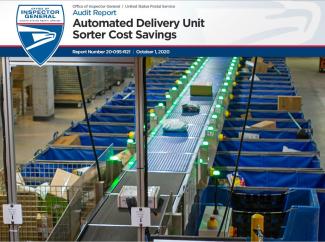Automated Delivery Unit Sorter Cost Savings
Objective
Our objective was to determine if the Postal Service’s Automated Delivery Unit Sorter (ADUS) achieved projected cost savings.
The Postal Service has deployed a wide range of automated sorting equipment to achieve cost savings associated with reducing less-efficient manual processing and enhancing productivity. The ADUS is one of its most recent efforts, automating the sorting of smaller packages (up to 30 pounds) in delivery units and small processing and distribution centers (P&DC).
Postal Service management issued two Decision Analysis Reports (DAR) in fiscal years (FY) 2017 and 2018 for the purchase and deployment of 20 ADUS machines for a combined [redacted]. These machines were installed at 10 delivery units and 10 small P&DCs across the country and were projected to capture cost savings of $8.8 million in FYs 2018 and 2019. These savings were based on reducing about 165,000 workhours and meeting other machine performance metrics, such as average daily volume and machine throughput.
Packages processed on the ADUS are sorted to specific bins for carrier routes or other separations, such as outgoing package processing. ADUS sorts packages to their destinating bins and drops them into a container, such as a sack, hamper, or wire container. The 20 ADUS machines in the DARs were configured to use between 50 and 184 bins.
After the Postal Service deployed the initial 20 machines, management developed a 2019 DAR for the purchase of 21 more machines. As of October 2019, there were 41 machines deployed at 25 delivery units and 16 P&DCs nationwide. Another 10 ADUS machines are planned in a 2020 DAR. We evaluated cost savings for the first 20 machines because the 21 machines from the 2019 DAR were not fully deployed. We selected nine of the initial 20 machines for physical observations of operations.
Our fieldwork was completed before the President of the United States issued the national emergency declaration concerning the novel coronavirus disease outbreak (COVID-19) on March 13, 2020. The results of this audit do not reflect process and/or operational changes that may have occurred as a result of the pandemic.
Findings
The Postal Service realized $3.4 million of the projected $8.8 million in labor cost savings from the deployment of 20 ADUS machines – a shortfall of $5.4 million. This shortfall was primarily the result of workhours for ADUS operations that were not included in the 2017 and 2018 DAR savings estimates.
Overall, the ADUS machines had a positive impact on operations because of their speed in processing packages compared to manual package sortation. However, we noted that the DAR estimates did not include workhours related to:
- Automated workhours in 2017: Estimates in the 2017 DAR did not include projections for operating hours on the ADUS machines. Instead, the DAR only provided manual workhour savings of 8,127 hours per year for Customer Service Operations (Function 4). In subsequent discussions in May 2020, Postal Service management provided estimated workhour savings in manual operations as well as estimated workhour usage in ADUS operations. As these estimates were not included in the DAR approved by Postal Service managers, OIG calculated the workhour savings using the approved DAR projections.
- The high number of bins on ADUS machines and the use of sacks: Thirteen of the 20 ADUS machines were configured to use between 104 to 184 bins. OIG found that six of the nine selected sites used sacks (to accommodate walking delivery routes or for other mail transportation needs) as mail containers, which resulted in more ADUS workhours. However, these sacks filled significantly faster than larger rolling hampers and had to be changed more often. The higher number of bins and the use of sacks required additional staffing, which resulted in additional workhours for the packages being processed. While the DAR discussed container options including sacks, it did not project workhour requirements associated with these options.
- Bundle sortation at five sites and outgoing package processing at three of those five sites: This required more staff to sort incoming bundles and outgoing packages, resulting in higher workhour usage than projected. While the DARs outlined bundle sortation and outgoing package processing capabilities as additional opportunities for machine usage, the DAR did not include workhour savings projections associated with bundle or outgoing package processing.
The ADUS machines were designed to optimize cost efficiencies, improve customer service, and generate a positive return-on-investment. Therefore, workhours needed for various ADUS machine configurations should be considered when evaluating operational efficiencies and achieving projected DAR savings.
Recommendations
We recommended the Vice President, Delivery Operations ensure the Decision Analysis Report (DAR) savings estimates for future Automated Delivery Unit Sorter (ADUS) machine purchases include workhours for all anticipated operations, including bundles and outgoing package processing, and for those machines that use a high number of bins and sacks.
We also recommended the Vice President, Delivery Operations and the Vice President Processing and Maintenance Operations, ensure staffing on ADUS machines remain within the parameters outlined in the DAR or as determined by management.

